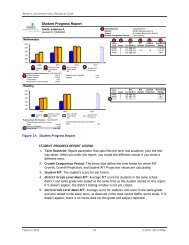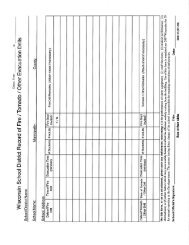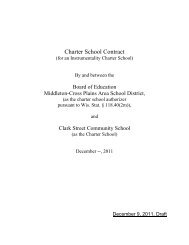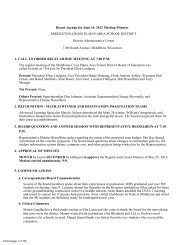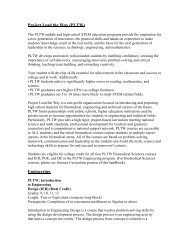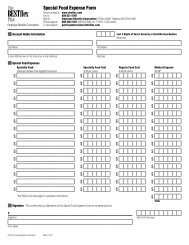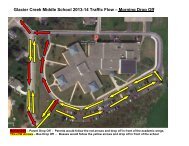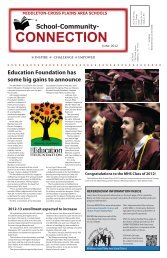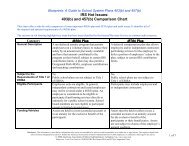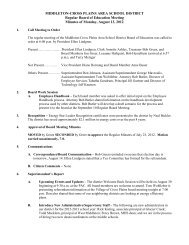Fourth grade curriculum guide - Middleton Cross Plains Area School ...
Fourth grade curriculum guide - Middleton Cross Plains Area School ...
Fourth grade curriculum guide - Middleton Cross Plains Area School ...
Create successful ePaper yourself
Turn your PDF publications into a flip-book with our unique Google optimized e-Paper software.
To educate all students to be<br />
contributing members of a<br />
global society by inspiring them<br />
<strong>Middleton</strong>-<strong>Cross</strong> <strong>Plains</strong> <strong>Area</strong><br />
<strong>School</strong> District<br />
with a lifelong love of learning,<br />
Elementary Curriculum Brochures<br />
challenging them with rigorous<br />
Grade Four<br />
http://www.mcpasd.k12.wi.us/<br />
<strong>curriculum</strong>, and empowering<br />
them with 21st century skills. To<br />
be an innovator and leader of<br />
public K-12 education within the<br />
state and nation by meeting the<br />
needs of all students with<br />
excellent programs and staff.<br />
P a g e | 1<br />
MCPASD 4th Grade Curriculum Brochure
Literacy<br />
Students in <strong>grade</strong>s third<br />
through fifth have a<br />
literacy block with a<br />
minimum of 90 minutes daily. This provides a<br />
focused time to develop skills in reading, writing<br />
and word study. MCPASD teachers use whole<br />
group instruction, small group instruction,<br />
individual instruction and independent practice to<br />
differentiate for the student learner.<br />
All students are actively engaged in learning<br />
whether they are in a small teacher led group of<br />
students or reading independently, or writing.<br />
Independent activities will often focus on concepts<br />
being studied in science, and social studies.<br />
Reading<br />
The National Reading<br />
Panel identified key skills<br />
and methods central to<br />
reading achievement.<br />
The five essential<br />
elements of reading<br />
instruction are what we<br />
teach. The elements are<br />
phonemic awareness,<br />
phonics, vocabulary, fluency, and comprehension.<br />
Current research states that systematic and explicit<br />
approaches to instruction in each of the major<br />
components are imperative.<br />
In the intermediate <strong>grade</strong>s, there is less focus on<br />
foundational skills (e.g., phonemic awareness and<br />
phonics), as most students have these skills.<br />
Instead, we focus more on word study, both from a<br />
vocabulary and spelling lens, at the intermediate<br />
level. Students also study genre and literary<br />
elements in more depth in <strong>grade</strong>s three through<br />
five.<br />
Balanced Literacy<br />
Balanced literacy is how we teach literacy. It<br />
involves several methods for teaching reading and<br />
writing. These essential literacy skills are taught in<br />
the context of authentic reading and writing<br />
experiences. There are eight components of<br />
P a g e | 2<br />
balanced literacy: reading aloud, shared reading,<br />
<strong>guide</strong>d reading, independent reading, modeled &<br />
shared writing, <strong>guide</strong>d writing, independent<br />
writing, and interactive writing.<br />
The power of the balanced literacy framework is<br />
the manner in which students are supported as<br />
they are exposed to new learning and <strong>guide</strong>d as<br />
they learn to use skills and strategies<br />
independently. During read alouds and modeled<br />
writing lessons, the teacher explicitly models<br />
his/her own thinking for students. Students are<br />
supported as they learn to apply new skills and<br />
strategies in authentic reading and writing tasks.<br />
Our ultimate goal is for students to take on the<br />
responsibility for these skills and strategies and be<br />
able to use them independently.<br />
Writing Process<br />
We use Units of Study for Teaching Writing,<br />
developed by Lucy Calkins and her colleagues from<br />
the Teachers College Reading and Writing Project.<br />
Each year, teachers deliver six “units of study,”<br />
each lasting four to six weeks.<br />
<br />
<br />
<br />
<br />
<br />
<br />
Launching the Writing Workshop<br />
Raising the Quality of Narrative Writing<br />
Breathing Life into Essays<br />
Writing Fiction: Big dreams, Tall Ambitions<br />
Literary Essays: Writing About Reading<br />
Memoir: The Art of Writing Well<br />
6 + 1 Traits<br />
Not only do we talk about<br />
the writing process, we<br />
also talk about the craft<br />
of writing. We use the<br />
common language of the<br />
6 + 1 Traits of Writing to<br />
discuss and describe<br />
authors’ craft. The 6 + 1<br />
traits include the<br />
following: ideas,<br />
organization, voice, word choice, sentence fluency,<br />
conventions, and presentation.<br />
MCPASD 4th Grade Curriculum Brochure
Mathematics<br />
Children’s experiences<br />
shape their attitude<br />
toward mathematics. The<br />
Everyday Mathematics<br />
<strong>curriculum</strong> is engaging,<br />
encouraging, and<br />
designed to build<br />
children’s understanding<br />
over time. This program respects children’s<br />
intuitive understanding of mathematics and helps<br />
them develop the range of sophisticated<br />
mathematical knowledge and skills necessary for<br />
success in our information and technology oriented<br />
world.<br />
In Everyday Mathematics, all students in <strong>grade</strong>s K-5<br />
develop a broad background by learning concepts<br />
and skills in the six content strands of Number and<br />
Numeration; Operations and Computation; Data<br />
and Chance; Measurement and Reference Frames;<br />
Geometry; and Patterns, Functions, and Algebra.<br />
The <strong>Fourth</strong> Grade program emphasizes the<br />
following content.<br />
Number and Numeration<br />
<br />
<br />
Reading, writing, and using whole numbers,<br />
fractions, decimals, percents, and negative<br />
numbers<br />
Exploring scientific notation<br />
Operations and Computation<br />
<br />
<br />
<br />
<br />
<br />
Practicing addition and<br />
subtraction to<br />
proficiency<br />
Developing<br />
multiplication and<br />
division skills<br />
Exploring addition, subtraction,<br />
multiplication, and division methods<br />
Inventing individual procedures and<br />
algorithms<br />
Experimenting with calculator procedures<br />
Data and Chance<br />
<br />
Collecting, organizing, and interpreting<br />
numerical data<br />
Measurement and Reference Frames<br />
<br />
<br />
<br />
<br />
Exploring metric and U.S. customary<br />
measures for length, area, volume, and<br />
weight<br />
Exploring geographical measures<br />
Using numbers in reference frames<br />
Using number lines, coordinates, times,<br />
dates, latitude and longitude<br />
Geometry<br />
Developing and intuitive sense about 2-<br />
dimensional and 3-dimensional objects,<br />
their properties, uses, and relationships<br />
Patterns, Functions, and Algebra<br />
<br />
<br />
Designing,<br />
exploring, and using<br />
geometric and<br />
number patterns<br />
Reading, writing and<br />
solving number<br />
sentences<br />
In Everyday Mathematics you can<br />
expect to see…<br />
<br />
<br />
<br />
<br />
<br />
A problem-solving approach based on<br />
everyday situations<br />
Key mathematical ideas repeated over time<br />
in slightly different ways<br />
Learning through age-appropriate, playful<br />
activities<br />
A broad range of mathematics topics based<br />
on an optimistic view of children’s<br />
capabilities and motivation to learn<br />
Opportunities to “do math” at home<br />
P a g e | 3<br />
MCPASD 4th Grade Curriculum Brochure
Science<br />
The <strong>Middleton</strong>-<strong>Cross</strong><br />
<strong>Plains</strong> <strong>Area</strong> <strong>School</strong><br />
District utilizes the Full<br />
Option Science System<br />
(FOSS) at the K-5 Level.<br />
FOSS strives to develop students' abilities to do and<br />
understand scientific inquiry through:<br />
<br />
<br />
<br />
<br />
<br />
<br />
Asking and answering questions<br />
Planning and conducting simple<br />
investigations<br />
Employing tools and techniques to gather<br />
data<br />
Using data to construct reasonable<br />
explanations<br />
Communicating investigations and<br />
explanations<br />
Understanding that scientists use different<br />
kinds of investigations and tools to develop<br />
explanations using evidence and knowledge<br />
The <strong>Fourth</strong> Grade program emphasizes the<br />
following content.<br />
The Structures of Life Module consists of<br />
investigations dealing with observable<br />
characteristics of organisms. Students observe,<br />
compare, categorize, and care<br />
for a selection of organisms, and<br />
in so doing they learn to identify<br />
properties of plants and animals<br />
and to sort and group organisms<br />
on the basis of observable properties. Students<br />
investigate structures of the organisms and learn<br />
how some of the structures function in growth and<br />
survival.<br />
worlds by observing and manipulating materials in<br />
focused settings using simple tools.<br />
The Earth Materials Module consists of<br />
investigations dealing with observable<br />
characteristics of solid materials from the earth—<br />
rocks and minerals. The focus is on taking materials<br />
apart to find what they are made of and putting<br />
materials together to better<br />
understand their properties.<br />
The module introduces<br />
fundamental concepts in<br />
earth science and takes<br />
advantage of the students' intrinsic interest in the<br />
subject matter and in the physical world around<br />
them.<br />
The Sun, Moon, and Stars Module consists of<br />
investigations designed<br />
to introduce students to<br />
objects we see in the<br />
sky. Through outdoor<br />
observations made<br />
during the day and at<br />
night, active<br />
simulations, readings,<br />
videos, and discussions, students study the Sun,<br />
Moon, and stars to learn that these objects move<br />
in regular and predictable patterns that can be<br />
observed, recorded, and analyzed.<br />
The Magnetism and<br />
Electricity Module consists of<br />
investigations designed to<br />
introduce or reinforce<br />
concepts in physical science.<br />
The investigations provide opportunities for<br />
students to explore the natural and human-made<br />
P a g e | 4<br />
MCPASD 4th Grade Curriculum Brochure
Social Studies<br />
The elementary social studies <strong>curriculum</strong> is based<br />
on the 2010 National Council for the Social Studies<br />
standards. The aim of social studies is the<br />
promotion of civic competence. Young people<br />
who are knowledgeable, skillful, and committed to<br />
democracy are necessary to<br />
sustaining and improving our<br />
democratic way of life, and<br />
participating as members of a<br />
global society. The national<br />
standards are focused on ten<br />
themes. These themes<br />
represent a way of categorizing knowledge about<br />
the human experience, and they constitute the<br />
organizing strands that thread through our<br />
elementary social studies program.<br />
<br />
<br />
<br />
<br />
<br />
<br />
<br />
<br />
<br />
<br />
P a g e | 5<br />
Culture<br />
Time, Continuity, and Change<br />
People, Places, and Environments<br />
Individual Development and Identity<br />
Individuals, Groups, and Institutions<br />
Power, Authority, and Governance<br />
Production, Distribution, and Consumption<br />
Science, Technology, and Society<br />
Global Connections<br />
Civic Ideals and Practices<br />
At the elementary level,<br />
these themes are explored<br />
through an ageappropriate<br />
“lens.” In<br />
fourth <strong>grade</strong>, the scope of<br />
the social studies<br />
<strong>curriculum</strong> is “Regions of<br />
the United States and Development of Wisconsin.”<br />
Teachers and students use a variety of materials<br />
and resources, including Wisconsin Historical<br />
Society: Wisconsin—Our State, Our Story, and<br />
Perfection Learning: US Regional Road Trip. Units<br />
of Study include the following:<br />
US Regions: Geography<br />
US Regions and Their History<br />
US Regions: Resources and Industry<br />
Wisconsin’s Resources<br />
<br />
<br />
<br />
Wisconsin Cultures and People: Native<br />
Americans; Fur Trade; Logging, Mining, and<br />
Agriculture; Immigration; and Science,<br />
Technology, and Industrialization<br />
Wisconsin Government<br />
Wisconsin Today<br />
Visual Arts<br />
Art is a way of understanding ourselves and our<br />
relationship with the world around us. Throughout<br />
the K-12 Art program, students explore the three<br />
essential questions of:<br />
<br />
<br />
<br />
What is art<br />
How is art created<br />
Why is art important<br />
Students explore the answers to the above<br />
questions when engaged in art experiences<br />
focused around the following six Art standards.<br />
Creation<br />
Understanding and applying media, techniques,<br />
and processes<br />
Perception<br />
Using knowledge of structures and functions<br />
Interpretation<br />
Choosing and evaluating a range of subject matter,<br />
symbols, and ideas<br />
Relation<br />
Understanding the visual arts in relation to history<br />
and cultures<br />
Reflection<br />
Reflecting upon and assessing the characteristics<br />
and merits of their work and the work of others<br />
Connection<br />
Making connections between visual arts and other<br />
disciplines<br />
MCPASD 4th Grade Curriculum Brochure
Music<br />
What Exactly Do We Do In Music Class<br />
The short answer to this question is that in music<br />
class we sing, play instruments, and learn about<br />
how music works. But there's more to it than that -<br />
music in the <strong>Middleton</strong>-<strong>Cross</strong> <strong>Plains</strong> <strong>Area</strong> <strong>School</strong><br />
District reflects the national music education<br />
standards, also adopted in the state of Wisconsin.<br />
Our Elementary Music Curriculum is based on<br />
students learning eight main concepts:<br />
Time: beat, rhythm, meter, rhythmic notation,<br />
playing rhythmic patterns on instruments, time<br />
signatures, improvising rhythms<br />
Pitch: matching pitch, relationship of pitches to<br />
each other,<br />
Melody: types of melodic<br />
movement, playing and singing<br />
melodies, improvising/composing<br />
melodies<br />
Harmony: performing<br />
accompaniments, learning to sing<br />
and play rounds, melodies with an<br />
ostinato, echo harmony, partner songs, countermelodies,<br />
simple harmonic theory<br />
Form: recognizing sounds that are the same or<br />
different; form (structure of songs/compositions),<br />
solo vs. group, types of form: AB, ABA, rondo,<br />
sonata, suite<br />
Expression: tempo, texture, dynamics,<br />
phrasing, and articulation<br />
Timbre: effects and mood, instrument families,<br />
world instruments, ensembles, and orchestra<br />
History and Culture: relationship of music to<br />
society, function of music, multicultural music,<br />
music of famous composers, music of American<br />
composers, musical styles<br />
The <strong>curriculum</strong> model designed<br />
to increase skill level throughout<br />
all conceptual areas as students<br />
get older is also known as a<br />
spiral <strong>curriculum</strong>. Over the<br />
course of the elementary music<br />
experience, the use of each<br />
concept becomes more sophisticated. For<br />
example, in regard to time, students learn about<br />
and practice keeping steady beat in kindergarten,<br />
but by 5 th <strong>grade</strong> are working on eight and sixteenth<br />
notes, as well as triplets and the offbeat.<br />
Technology<br />
As foundational technology skills<br />
penetrate throughout our society,<br />
students will be expected to apply the<br />
basics in authentic, integrated ways<br />
to solve problems, complete projects,<br />
and creatively extend their abilities. Students at the<br />
elementary level participate in technology<br />
enrichment classes, and students in <strong>grade</strong>s 4 and 5<br />
participate in keyboarding classes. The technology<br />
standards and <strong>curriculum</strong> help students prepare to<br />
work, live, and contribute to the social and civic<br />
fabric of their communities.<br />
Technology standards addressed at the elementary<br />
level identify several higherorder<br />
thinking skills and digital<br />
citizenship as critical for<br />
students to learn effectively for<br />
a lifetime and live productively<br />
in our emerging global society. These areas include<br />
the ability to:<br />
<br />
<br />
<br />
<br />
<br />
Demonstrate creativity and innovation<br />
Communicate and collaborate<br />
Conduct research and use information<br />
Think critically, solve problems, and make<br />
decisions<br />
Use technology effectively and productively<br />
These eight concepts are geared towards students<br />
increasing in skill level in each of the eight areas.<br />
P a g e | 6<br />
MCPASD 4th Grade Curriculum Brochure
Physical<br />
Education<br />
Physical activity is<br />
critical to the<br />
development and<br />
maintenance of<br />
good health. The<br />
goal of physical<br />
education is to develop physically educated<br />
individuals who have the knowledge, skills and<br />
confidence to enjoy a lifetime of healthful physical<br />
activity. A physically educated person:<br />
Ideas and Resources for Parents<br />
Hide an object in a room of your house,<br />
and give your child directions for finding it.<br />
Have your child practice math games at<br />
www.everydaymathonline.com<br />
Play a card or board game.<br />
http://www.fossweb.com/<br />
http://www.pta.org/4th%20Grade_B-<br />
W.pdf<br />
Standard 1:<br />
Demonstrates competency in motor skills and<br />
movement patterns needed to perform a variety of<br />
physical activities.<br />
Standard 2:<br />
Demonstrates understanding of movement<br />
concepts, principles, strategies, and tactics as they<br />
apply to the learning and performance of physical<br />
activities.<br />
Standard 3:<br />
Participates regularly in physical activity.<br />
Standard 4:<br />
Achieves and maintains a health-enhancing level of<br />
physical fitness.<br />
Standard 5:<br />
Exhibits responsible personal and social behavior<br />
that respects self and others in physical activity<br />
settings.<br />
Standard 6:<br />
Values physical<br />
activity for health,<br />
enjoyment,<br />
challenge, selfexpression,<br />
and/or<br />
social interaction<br />
P a g e | 7<br />
MCPASD 4th Grade Curriculum Brochure



